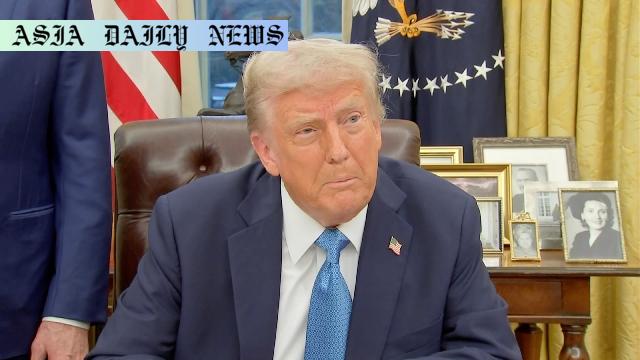Tariffs: US announces 25% tariffs on Canada, Mexico, including 10% on China, to combat illegal drugs and immigration threats.
Tariffs imposed by the US include 25% on Canada and Mexico, 10% on China.
They aim to address the national threats of illegal drugs and immigration.
Canada, Mexico, and China retaliate with countermeasures.
China files a formal lawsuit with the WTO.

Introduction: The US Tariff Escalation
The United States has announced the implementation of tariffs on goods imported from Canada, Mexico, and China. This decision, spearheaded by President Donald Trump, comes as a response to what the government considers a national emergency involving the flow of illegal immigrants and drugs, particularly fentanyl. Enforced under the International Emergency Economic Powers Act (IEEPA), the tariffs will take effect on Tuesday and are poised to have significant economic ramifications globally.
Specifics of the Tariff Plan
The measures include a 25% tariff on imports from Canada and Mexico, with an additional 10% tariff on certain energy products from Canada. Goods from China will face a 10% tariff increase. President Trump described these measures as necessary to safeguard Americans from deadly drugs and illegal migration, framing these as posing “an extraordinary threat” to national security and economic stability.
Global Backlash and Retaliatory Actions
The announcement has sparked strong reactions from the international community. Canadian Prime Minister Justin Trudeau held a press conference expressing disappointment with the US decision, stating that tariffs on Canadian goods would have “real consequences” for the US economy. Trudeau also announced that Canada would impose a matching 25% tariff on American imports.
Meanwhile, Mexico has decided to respond with both tariffs and non-tariff barriers. Mexican President Claudia Sheinbaum instructed economic authorities to implement measures as part of their response strategy. In addition, China has expressed its firm opposition, with a commerce ministry spokesperson announcing that China will file a complaint with the World Trade Organization (WTO) and adopt corresponding countermeasures. This chain reaction risks escalating tensions among the involved nations.
Political and Economic Implications in the US
The decision to impose these tariffs is not without domestic criticism. Economic analysts warn that such tariffs could result in higher costs for American consumers, disrupt supply chains, and lead to retaliatory measures that may harm US exporters. Supporters of the move, however, argue that it underscores the administration’s commitment to national security, particularly concerning the fight against illegal drugs such as fentanyl.
Within the political landscape, opinions are divided. Advocates of strict immigration laws and measures against drug trafficking are lauding this move, while opponents see it as overly aggressive and detrimental to international relations, especially with neighboring nations and key trading partners.
The Broader International Consequences
The ripple effects of this action may extend beyond the current players. By invoking the IEEPA framework, the US has signaled its readiness to leverage trade as a tool for addressing national emergencies. Such a precedent could inspire other nations to adopt similar unilateral trade measures, potentially undermining global trade norms and increasing economic uncertainties.
Additionally, China’s decision to approach the WTO highlights the growing use of international legal forums to protest unilateral actions. It remains to be seen how the WTO will address this case and whether it might prompt reforms in addressing interstate trade disputes.
Conclusion: A Tense Moment in Global Trade
The US tariffs on Canada, Mexico, and China represent a significant moment in contemporary global trade. While intended to address crucial issues of national security, their economic and political repercussions are vast. As nations respond with their countermeasures, the possibility of escalating tensions looms large. The coming weeks will serve as a critical period to assess whether dialogue and diplomacy can prevail, or if the world will witness a deeper entrenchment of economic protectionism.



Commentary
Tariffs as a Double-Edged Sword
The announcement of tariffs by the United States has reignited debates around the pros and cons of protectionist trade policies. On one hand, using trade measures as leverage allows governments to address significant geopolitical and domestic challenges, such as illegal drugs and immigration. However, these tools can lead to far-reaching consequences, potentially harming allies, the economy, and global trade norms.
The Fallout of Economic Nationalism
While President Trump’s stance may resonate with segments of his domestic base, it’s clear that this move has created international friction. Economic nationalism, while prioritizing domestic interests, often alienates important allies. Canada’s and Mexico’s retaliatory actions highlight the risks of isolating key trading partners and underestimating the economic interdependencies in North America.
What Lies Ahead?
The global trade landscape faces an uncertain future with the introduction of these tariffs. Questions around how the WTO will respond to China’s legal challenge and whether this escalation will encourage more unilateral measures are important considerations. A balanced approach focusing on collaborative solutions rather than punitive measures could help strike a middle ground between national security interests and global economic stability.
Ultimately, while the intent to protect citizens and combat threats like fentanyl trafficking is commendable, the path chosen may come with unintended consequences. Diplomacy and dialogue, rather than economic isolation, might yield long-term solutions with fewer costs to all parties involved.